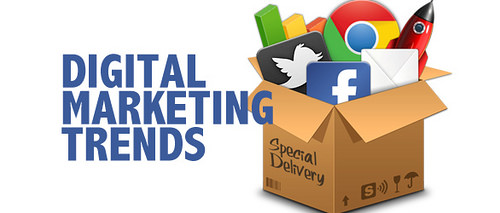11 Digital Marketing Trends and Predictions For 2016

It is that time of year again when we begin to take stock of the changes that have taken place in the world of digital marketing over the previous year, and look forward to emerging trends that are set to become important during 2016. Some of the trends and predictions mentioned below may seem to come out of ‘left field’, and it will be interesting to see what the impact of these new technologies really is when we look back on these predictions in 12 months’ time. Others are continuations, or developments of current trends and technologies.
Here is our analysis of the 11 digital marketing trends and technologies that will shape the world of digital marketing in 2016:
1. The emergence of virtual reality as a practical business technology
So-called Virtual Reality technologies have been spoken about for more than 20 years. The most exciting recent development in VR is the Occulus Rift, which is set to become commercially available in the first quarter of 2016. Several other devices are also in the development stage, with release dates scheduled between 2016 and 2020.
The first generation of Virtual Reality headsets are designed for use in online video games but other applications are soon to be explored, such as graphic design, training simulations, therapy, cloud-based work environments and online shopping. The devices open up completely new opportunities for Internet advertising and targeted marketing, as well as the potential to integrate online retail and social media channels. Watch this space.
2. Wearable technology and the Internet of Things (IoT)
The failure of Google Glass may have put wearable technology back a couple of years, but there are signs that this trend is about to leap into the foreground once again. While Virtual Reality offers a complete immersion experience, wearable technologies such as Microsoft HoloLens, Google Glass and the Apple Smart Watch provide an ‘augmented reality’ experience.
‘Smartwatches’ have been drifting onto the market over the past year, but currently they are linked to smart phone devices and provide only limited functionality. Next year, true, independent smartwatches and other wearables are set to be released, which are designed to interact with an ‘Internet of Things’ (IoT). By the end of 2016, adoption of wearable technologies is predicted to be as high as 28% .
The IoT concept refers to the growing number of physical objects that are embedded with electronics, sensors, operating systems and Internet connectivity. These range from smart phones and tablets down to car keys, e-book readers and even domestic appliances. The interaction of this ‘Internet of Things’ with wearable technologies will completely transform the way people search for information and interact with marketing data.
This trend may not reach full fruition in 2016, but we expect to see the first practical applications of these technologies in a marketing setting.
3. Mobile overtakes desktop
This has been on the cards for some time. This year mobile Internet traffic overtook desktop-based traffic in ten different countries for the first time. At the same time, Google adjusted their search algorithms to penalise websites that were not adapted for mobile devices. This is a rapidly developing trend and one that is set to increase over 2016. Expect to see a drastic increase of mobile oriented websites, apps and services, which may or may not come with a desktop counterpart. Businesses should take note of this shift when planning website redesigns, and starting to think ‘mobile first’.
4. Video ads come of age
Video adverts are nothing new, but in 2016 Google is set to introduce video ads into its search results page for the first time. This will result in a proliferation of video advertising and open up exciting new opportunities for business to business marketing. Video content will need to respond to this new opportunity by becoming more targeted, subtle and creative in order to grab the attention of its target audience.
5. Google app indexing and an explosion of dedicated mobile apps
Another potential trend for 2016 driven by changes in Google indexing. Google has already started indexing apps when linked to mobile-friendly websites, adding to the already growing demand for dedicated mobile apps. The trend is set to accelerate rapidly over the next year. Currently, apps are usually designed to supplement and enhance a mobile website. With Google set to give full indexing privileges to mobile apps, we may see apps beginning to phase out websites altogether in some sectors. Expect to see the emergence of fully functional mobile apps with all the features of a website, but presented in a more flexible, intuitive and dynamic way. For business owners this opens up a whole new world of creative marketing potential.
6. Digital Assistant Optimisation
Digital assistants such as Apple Siri and Cortana have been growing in popularity over the last few years. Current generations of these Digital Assistants utilise traditional search engines to extract the information requested. However, upcoming upgrades are set to transform Siri and company into full Voice Activated Search Engines, using traditional search engines only where necessary to find the data required. This means that businesses need to optimise their online apps and websites so that their information is easily accessible to the digital assistants. This is a whole new field of search optimisation, which in 2016 may begin to go hand-in-hand with the more traditional disciplines of SEO and Pay per click (PPC).
7. King Content is secure on his throne
All indications are that content will remain king in 2016, despite the predicted growth in user driven mobile apps and digital technology. A recent study undertaken by the Content Marketing Institute shows that 80% of decision-makers make their business choices based on written information on websites and articles, rather than from adverts. 78% of customer organisations saw written content as an essential element of their relationship with their supplier and 90% of respondents claimed they found targeted content useful in making purchase decisions.
Add to this the fact that content marketing remains significantly cheaper than other forms of outbound marketing using other technologies and you have a sound reason to continue investing in your blog and website throughout 2016.
8. Relationship marketing and the evolution of sales
he salesperson going all out to secure a one-off sale is becoming a thing of the past. The future of marketing in 2016 is increasingly going to be based on relationship building, developing a customer journey over time. This will necessitate a greater knowledge of your target market, with increased use of analytics and social media outreach, combined with targeted content that engages your audience.
Loyalty and engagement are the keys here. Not only do you want your customer’s money, but you also want to nurture them into brand advocates, increasing the number of leads generated by social media mentions and word-of-mouth referrals.
This will see the continued shift from old school sales tactics to a more consultative, relationship-building and helpful form of sales – call it social selling, call it inbound selling, call it what you will, it is here to stay.
9. The growth of marketing automation
Marketing has become a complex and time-consuming field. Today’s marketing professionals spend more than half their time creating content. Driven by the need to optimise the time available to them, marketing automation software is becoming increasingly popular.
Marketing Automation Platforms are software programs that enable users to schedule social media posts, manage content, facilitate email marketing and monitor outreach and customer engagement. Worldwide, this market is estimated at being worth more than $5.5 billion, and is showing no sign of slowing down. There are currently dozens of different Marketing Automation Platforms available, and 2016 is set to see increased variety and a reduction in prices.
10. Integration of Search engines, payment platforms and social media
At the end of the day, consumers, whether individuals or businesses, appreciate simplicity. Since the advent of the smart phone technologies have been struggling with the task of integrating all the search engines, payment platforms and social media outlets that people use on a daily basis. The goal is one, unified, seamless user experience.
The new generation of smart phones, combined with Augmented Reality wearable devices and Virtual Reality environments, may finally make this a reality. This is going to have enormous implications on how companies conduct digital marketing for B2B purposes. Imagine a platform where a customer can directly engage with your brand, purchase your services and discuss their decisions in real time with their social media network. This environment is already emerging and will become more important during 2016.
11. Analytics and micro-targeting
Social media, mobile apps and website-based promotions have led to a proliferation of data being available on our customers. Businesses now have more access to personal data than ever before. A study by the Direct Marketing Association revealed that 76% of consumers are happy to share personal information if they believe this will improve their customer experience. In return, customers expect an extremely personalised level of service, with marketing and content made directly relevant to them. For this to be possible, powerful analytics is required to streamline and segment all the data available. Expect this to be a trend that continues throughout 2016 and beyond.
Digital marketing is a rapidly changing and extremely exciting field. By embracing new technologies and trends you give yourself an edge when building relationships and communicating your brand to your target market. Our team of creative marketing enthusiasts are on hand to provide you with all the knowledge and technology you need to get the best ROI from your marketing budget in 2016.


